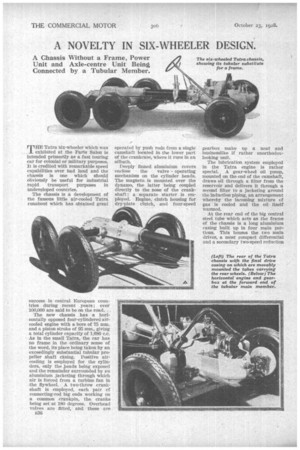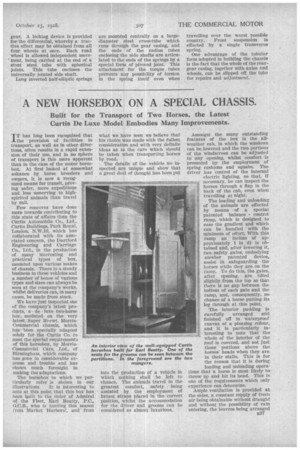A NOVELTY IN SIX-WHEELER DESIGN.
Page 20

Page 21

If you've noticed an error in this article please click here to report it so we can fix it.
A Chassis Without a Frame, Power Unit and Axle-centre Unit Being Connected by a Tubular Member.
TAE Tatra six-wheeler which was exhibited at the Paris Salon is intended primarily as a fast touring car for colonial or military purposes. It is credited with remarkable speed capabilities over bad land and the chassis is one which should obviously be useful for industrial rapid transport purposes in undeveloped countries.
The chassis is .a development of the famous little air-cooled Tatra runabout which has obtained great success in central European countries during recent years ; over 100,000 are said to be on the road.
The new chassis has a horizontally opposed four-cylimlered aircooled engine with a bore of 75 mm. and a piston stroke of 95 mm., giving a total cylinder capacity of 1,680 c.c. As in the small Tatra, the car has no frame in the ordinary sense of the word, its place being taken by an exceedingly substantial tubular propeller shaft casing. Positive aircooling is employed for the cylinders, only the heads being exposed and the remainder surrounded by an aluminium jacketing through which air is forced from a turbine fan in -the flywheel. A two-throw crankshaft is employed, each pair of connecting-rod big ends working on a common crankpin, the cranks being set at 180 degrees. Overhead valves are fitted, and these are 30 operated by push rods from a single camshaft located in the lower part of the crankcase, where it runs in an oilbath.
Deeply finned aluminium covers enclose the • valve operating mechanism on the cylinder heads. The magneto. is mounted over the dynamo, the latter being coupled directly to the nose of the crankshaft ; a separate starter is em-. played. Engine, clutch housing for dry-plate clutch, and four-speed gearbox make up a neat and Misinesslike if rather unorthodoxlooking unit.
The lubrication system employed in the Tatra engine is rather special.. ..gear-wheel oil pump, mounted on the end of the camshaft, draws oil through a filter from the reservoir and delivers it through a second filter to a jacketing around the induction piping, an arrangement whereby the incoming mixture of gas is cooled and the oil itself warmed.
At the rear end of the big central steel tube which acts as the frame of the chassis is a long aluminium casing built up in four main portions. This houses the two main drives, a most compact differential and a secondary two-speed reduction
gear. A locking device is provided for the differential, whereby a tractive effect may be obtained from all four wheels at once. Each road wheel is allowed independent move' ment, being carried at the end of a stout steel tube with spherical joints. This tube encloses the universally jointed side shaft.
Long inverted half-elliptic springs are mounted centrally on a largediameter steel cross-tube which runs through the gear casing, and the ends of the radius tubes enclosing the side shafts are articulated to the ends of the springs by a special form of pivoted joint. This attachment for the torque tubes prevents any possibility of torsion in the spring itself even when travelling over the worst possible country. Front suspension is effected by a single transverse spring.
One advantage of the tubular form adopted in building the chassis is the fact that the whole of the reargear casing, together with axles and wheels, can be slipped off the tube for repairs and adjustment.


































